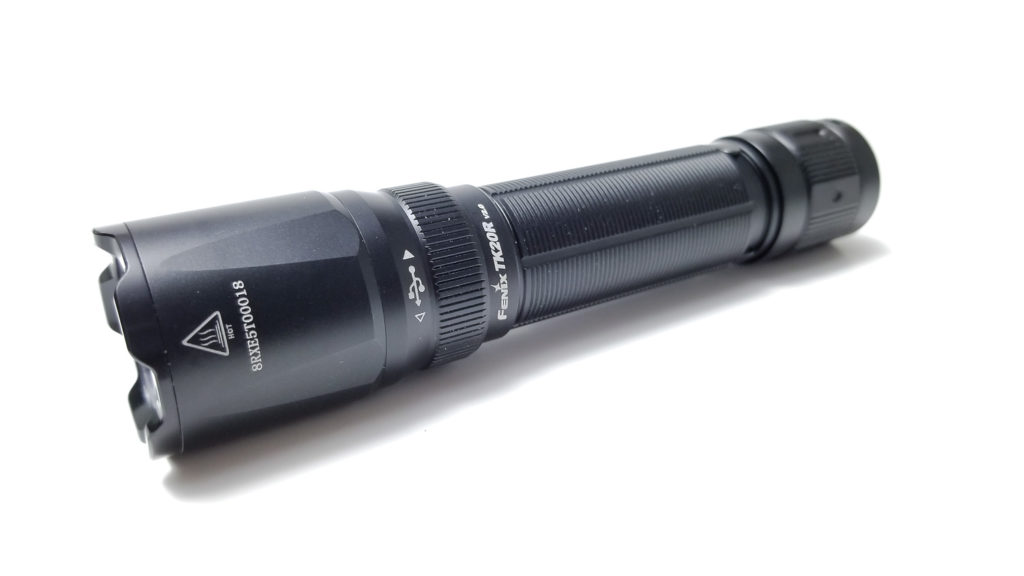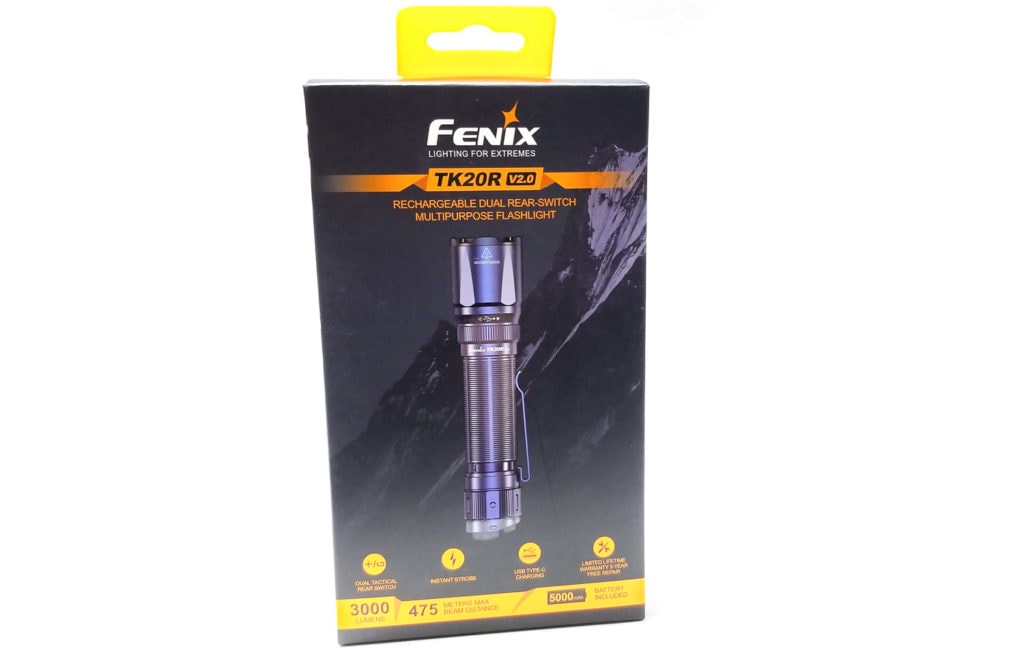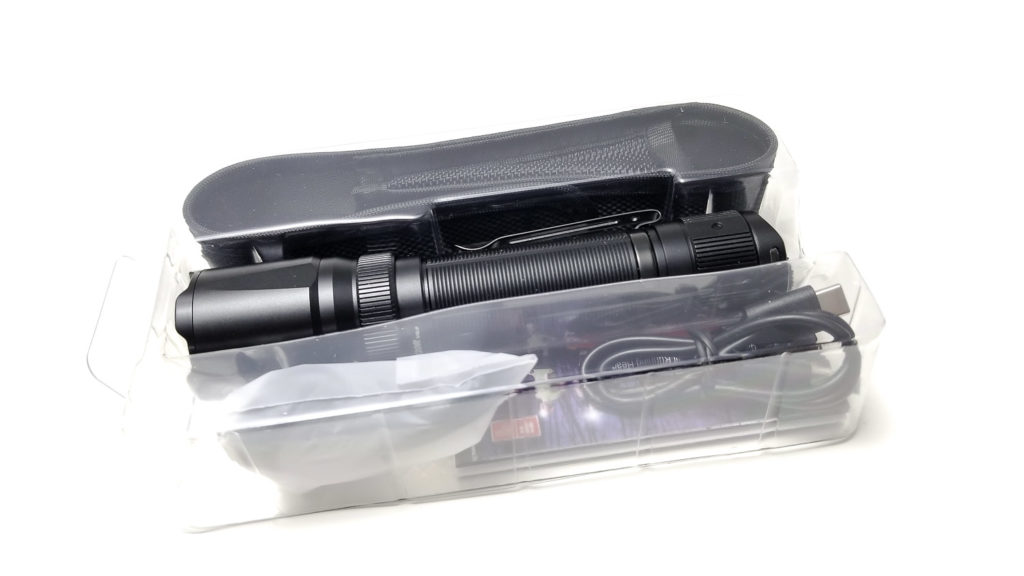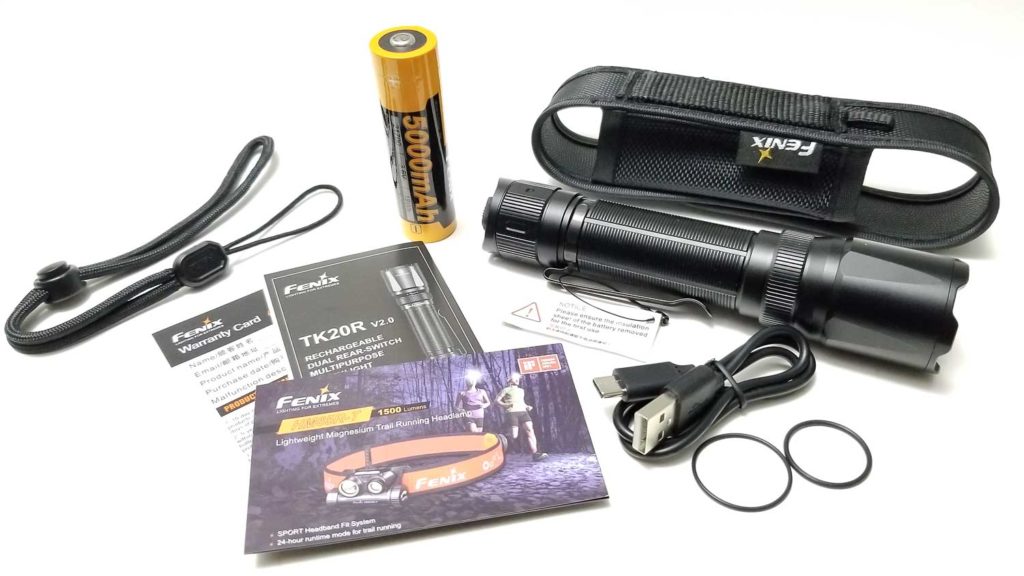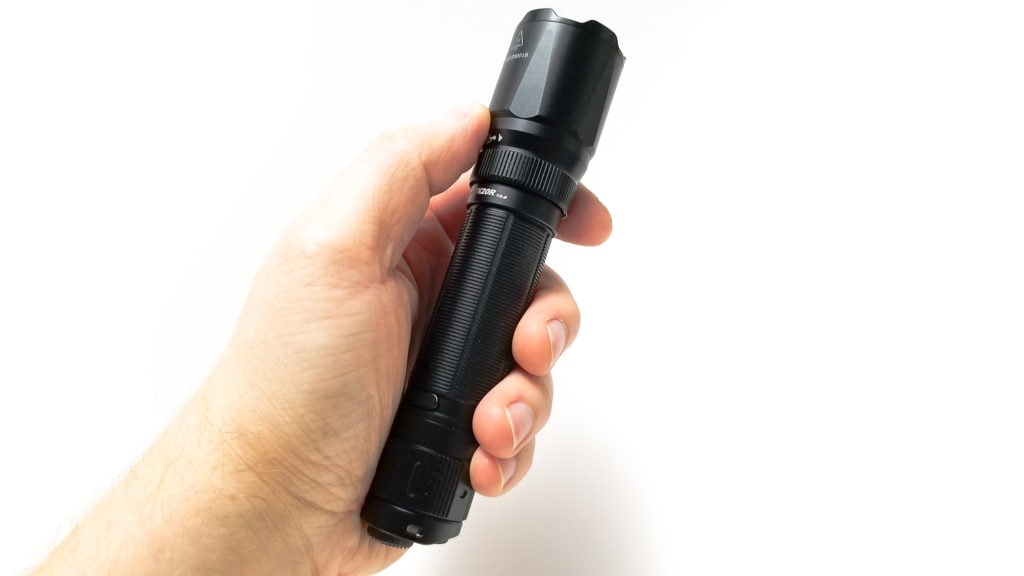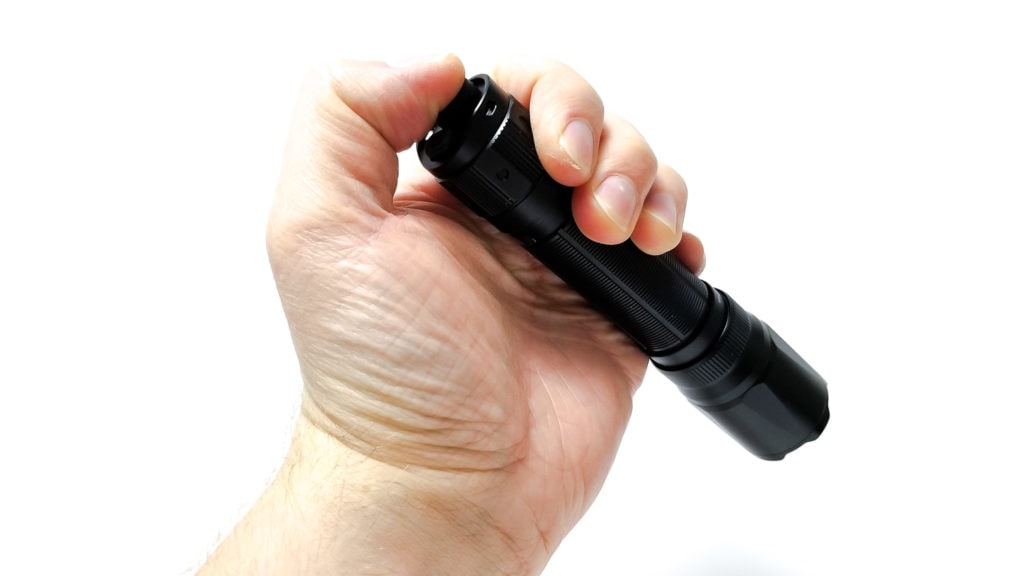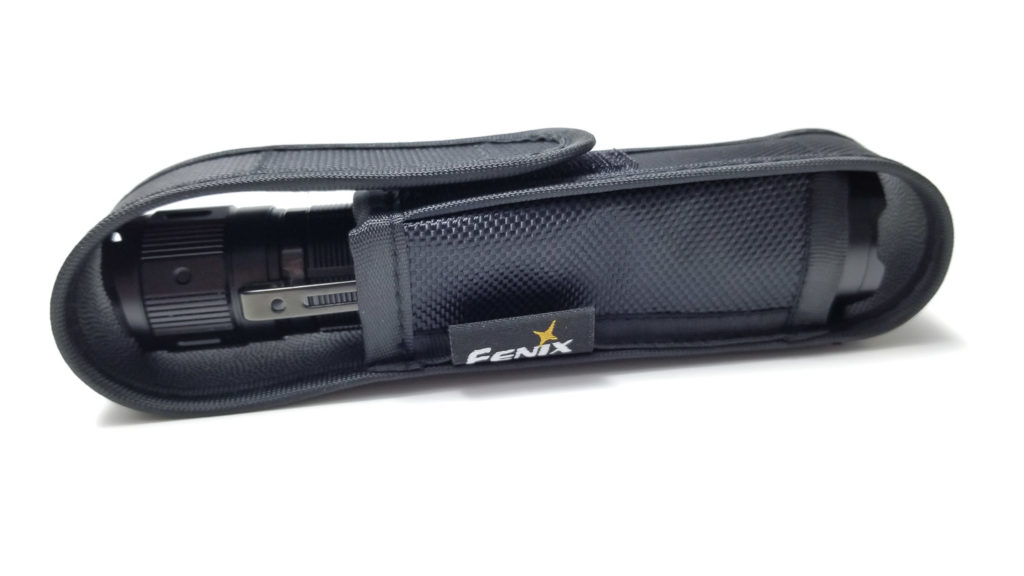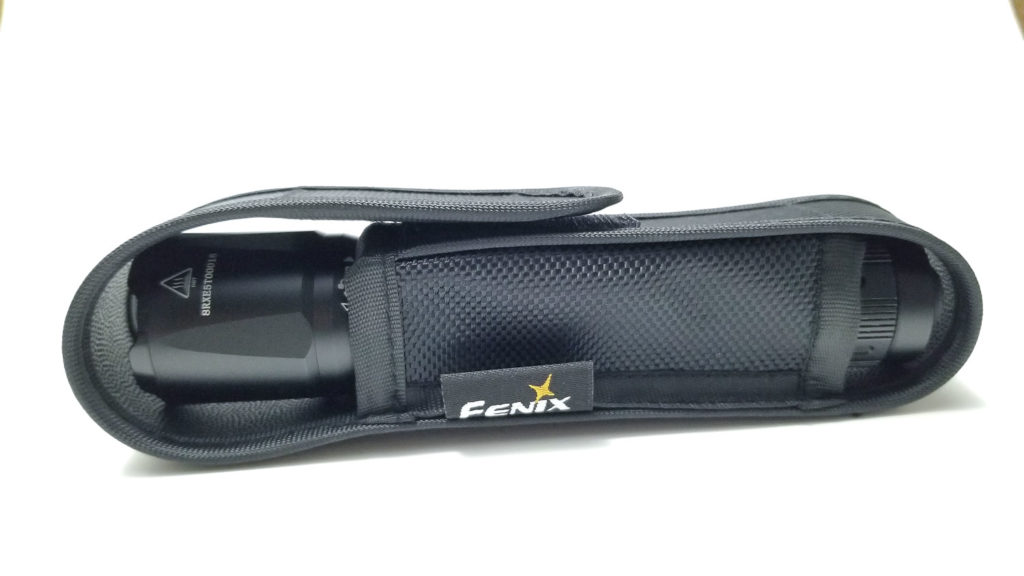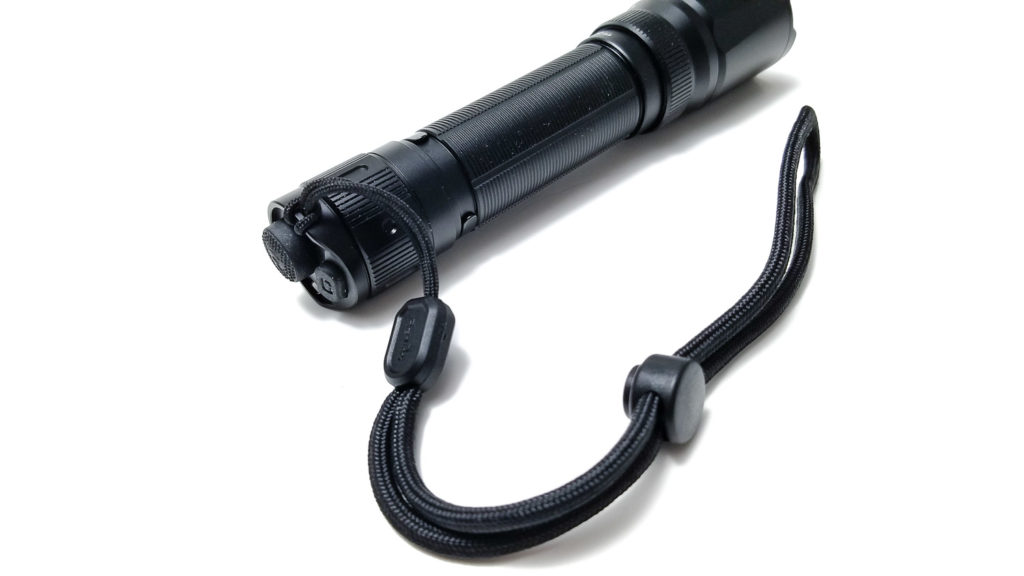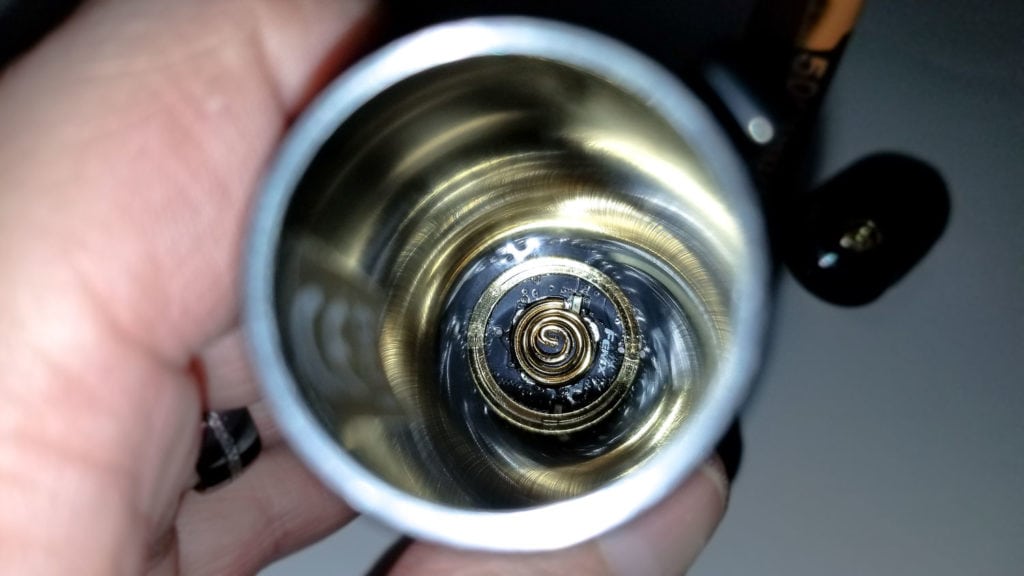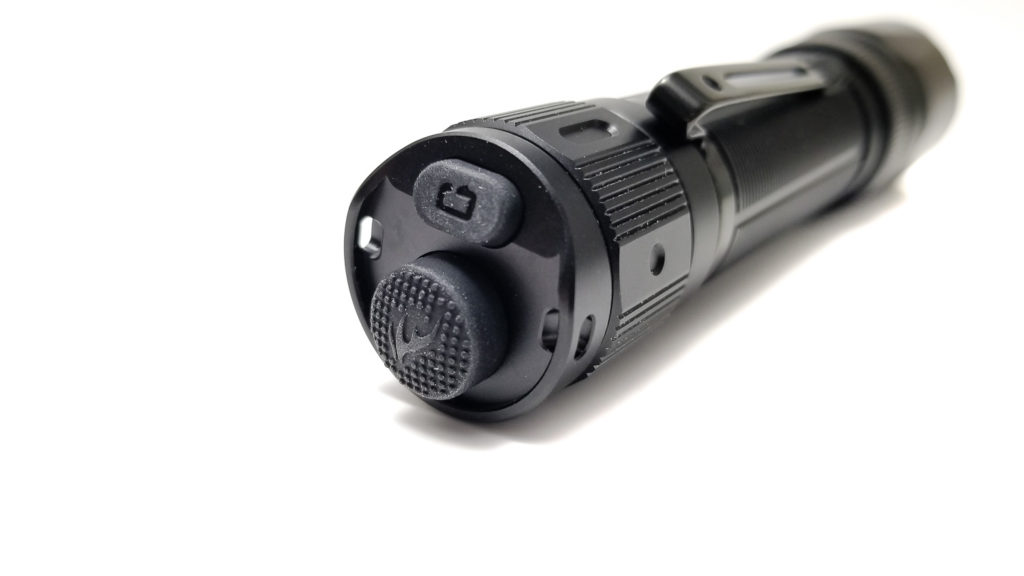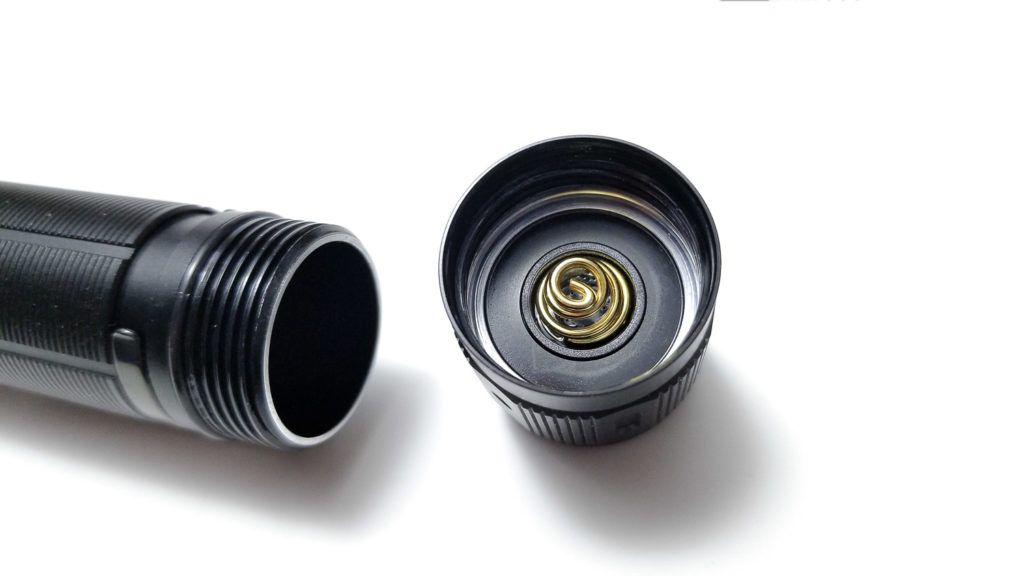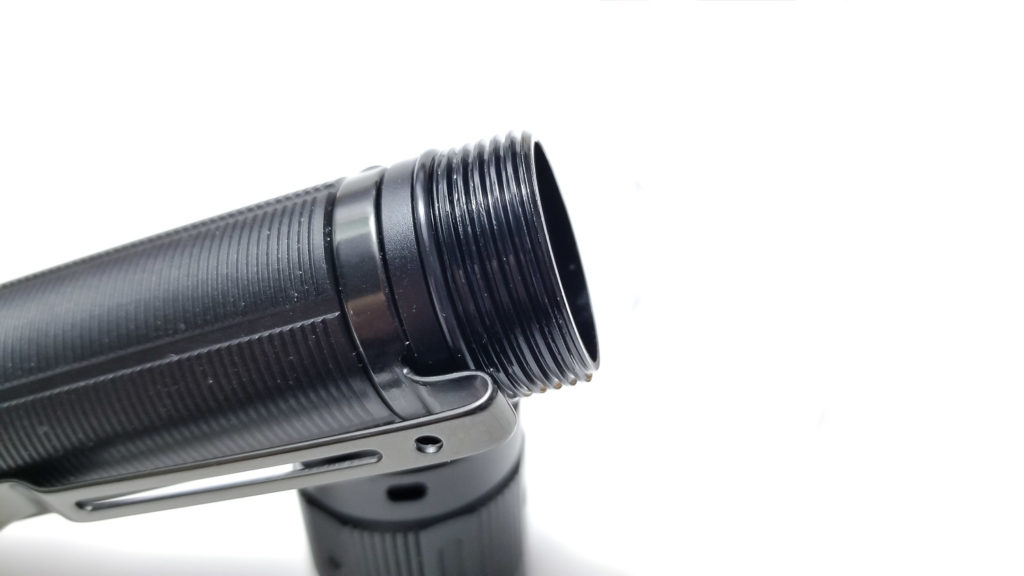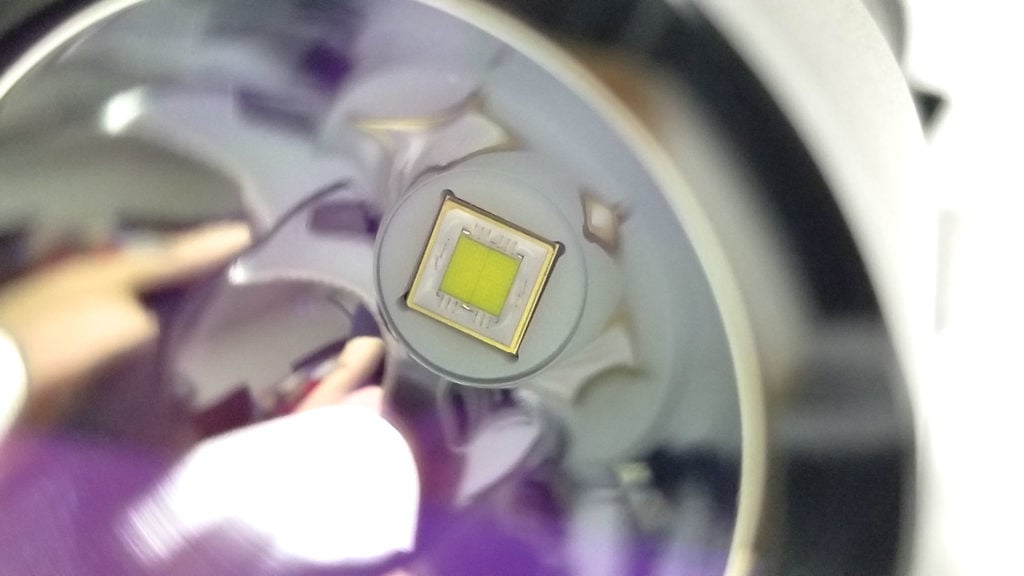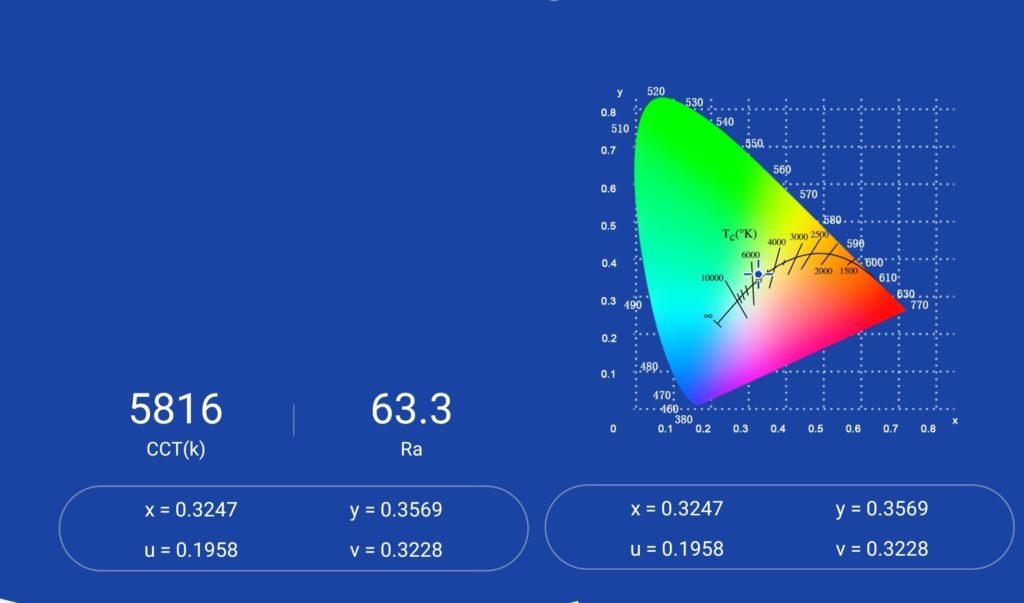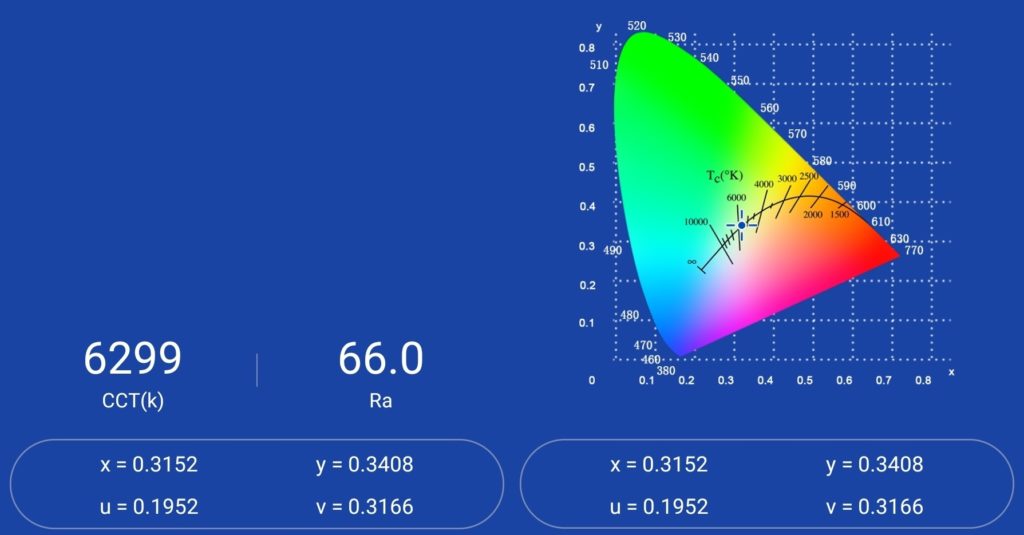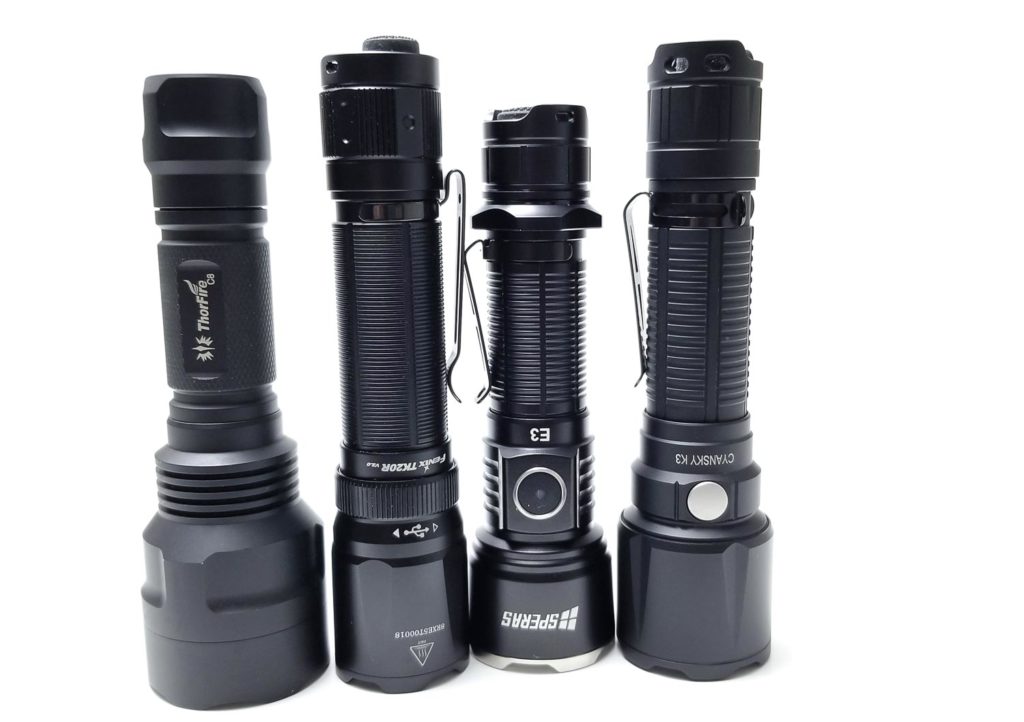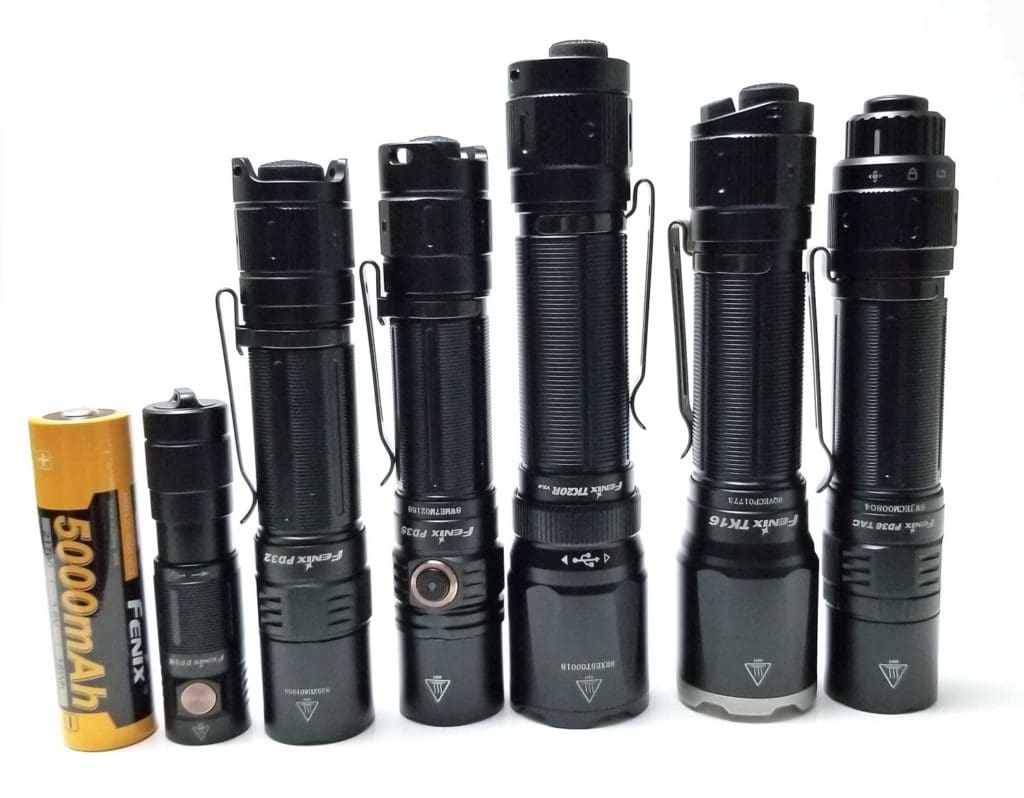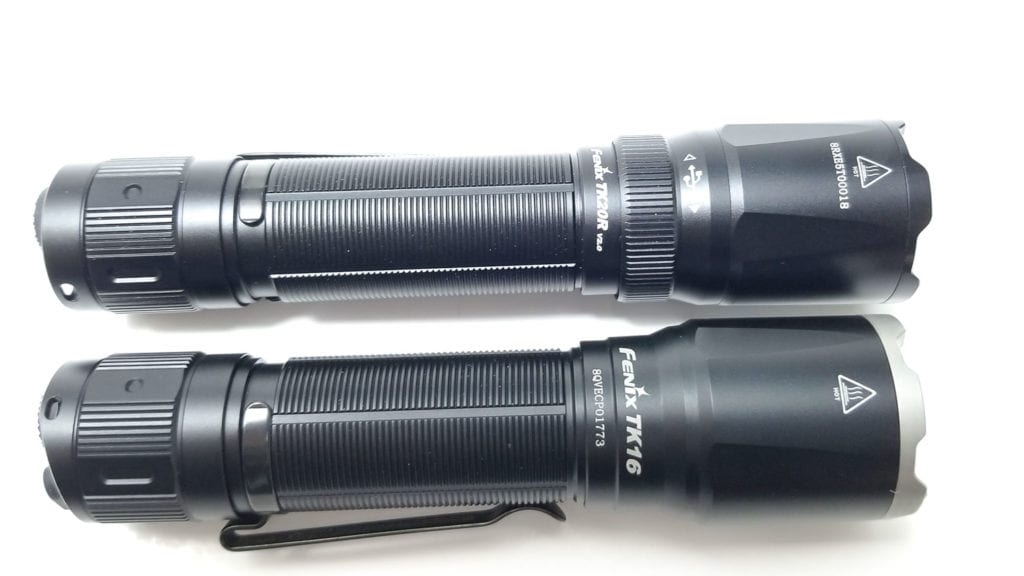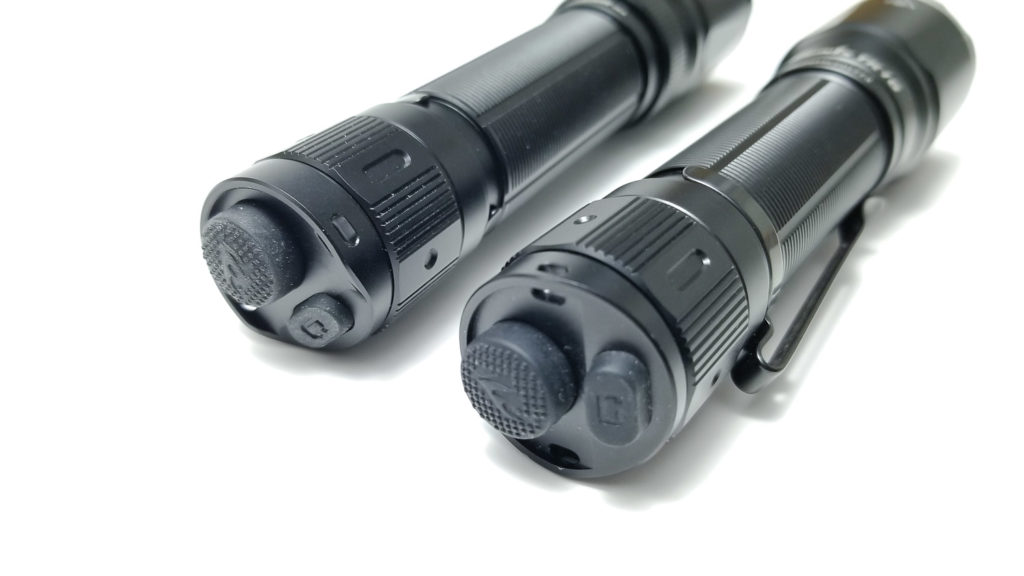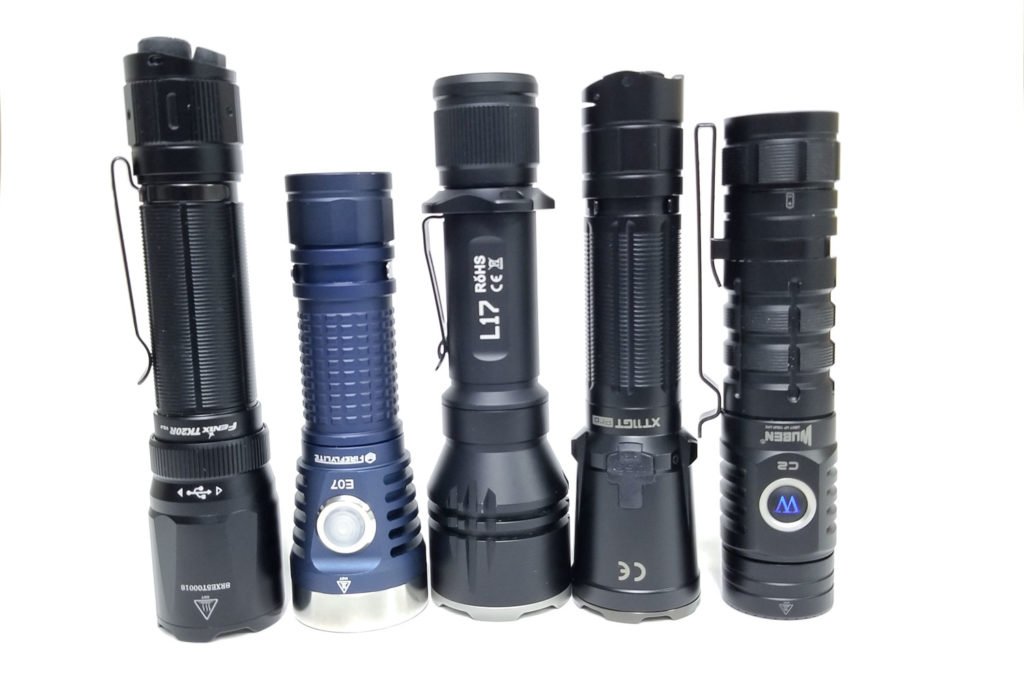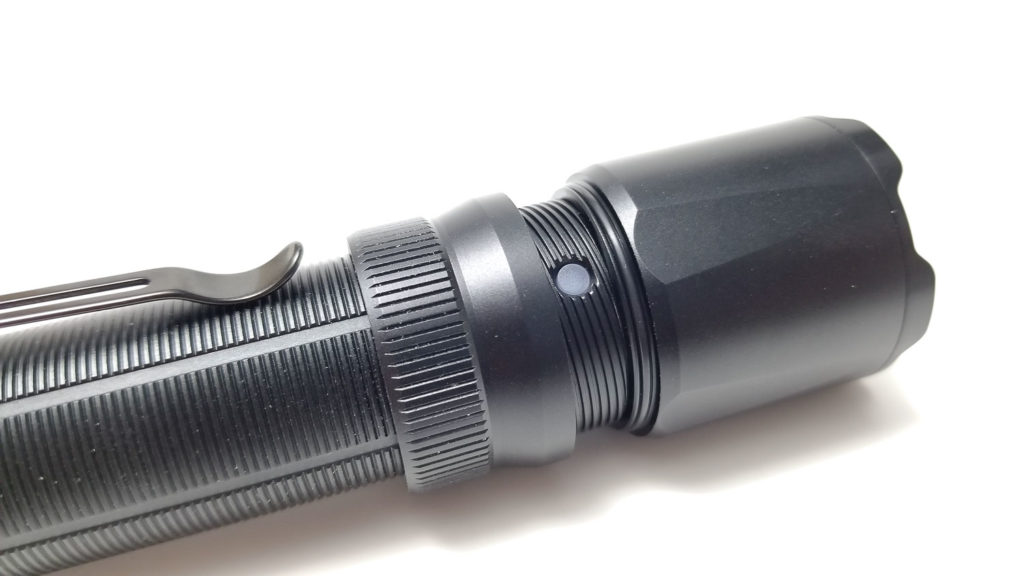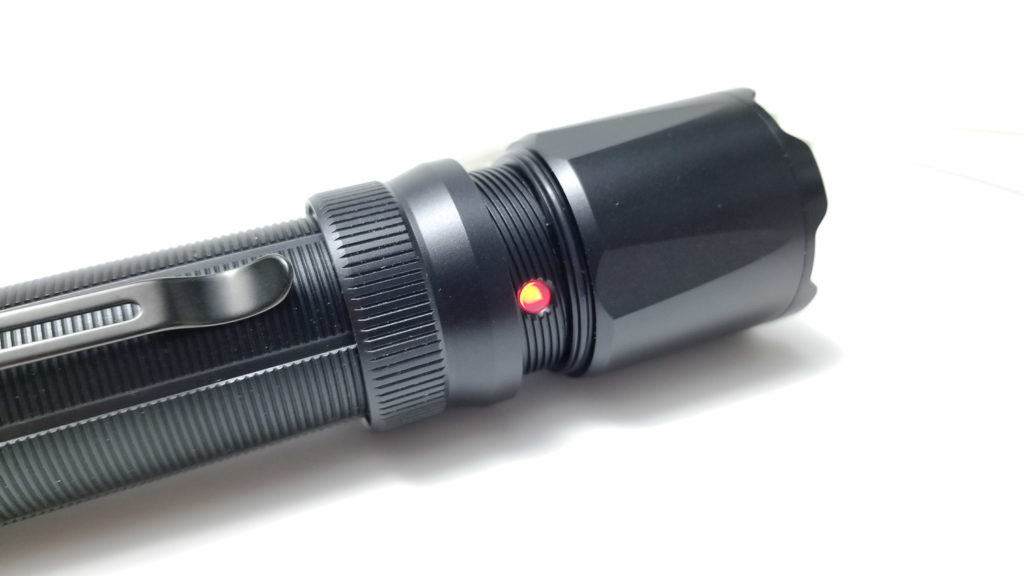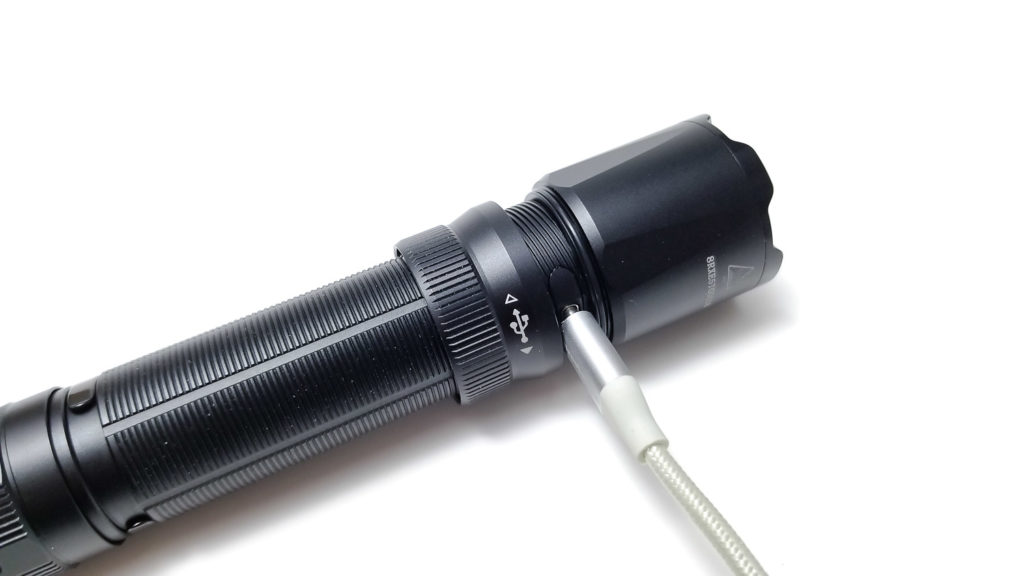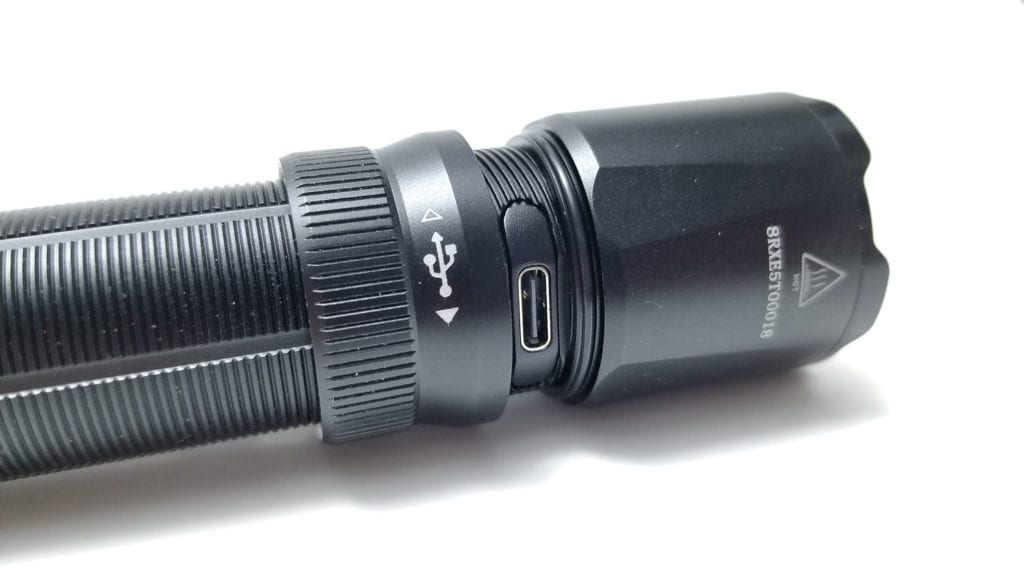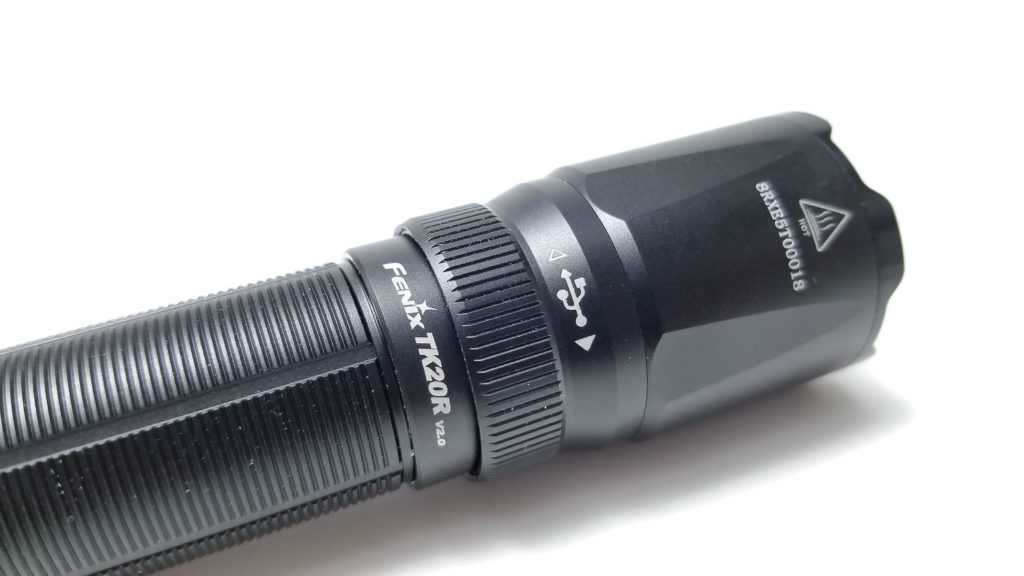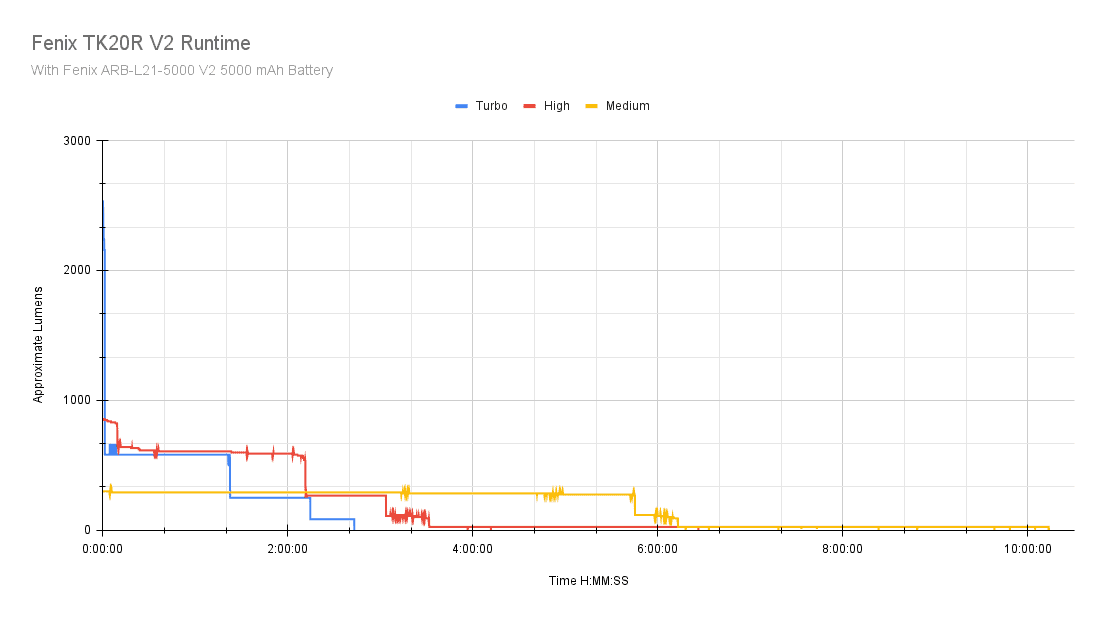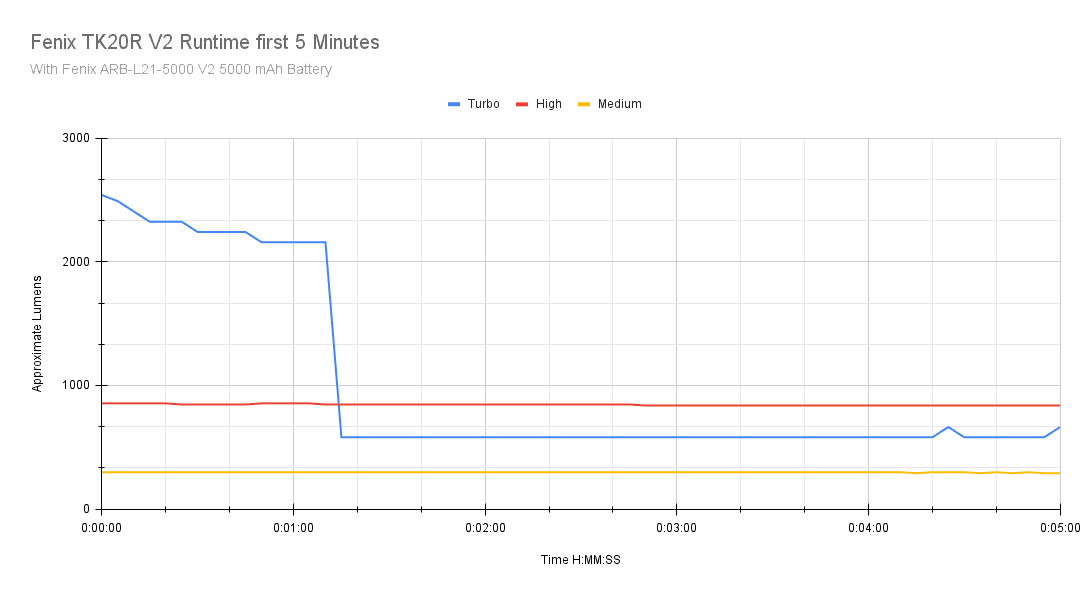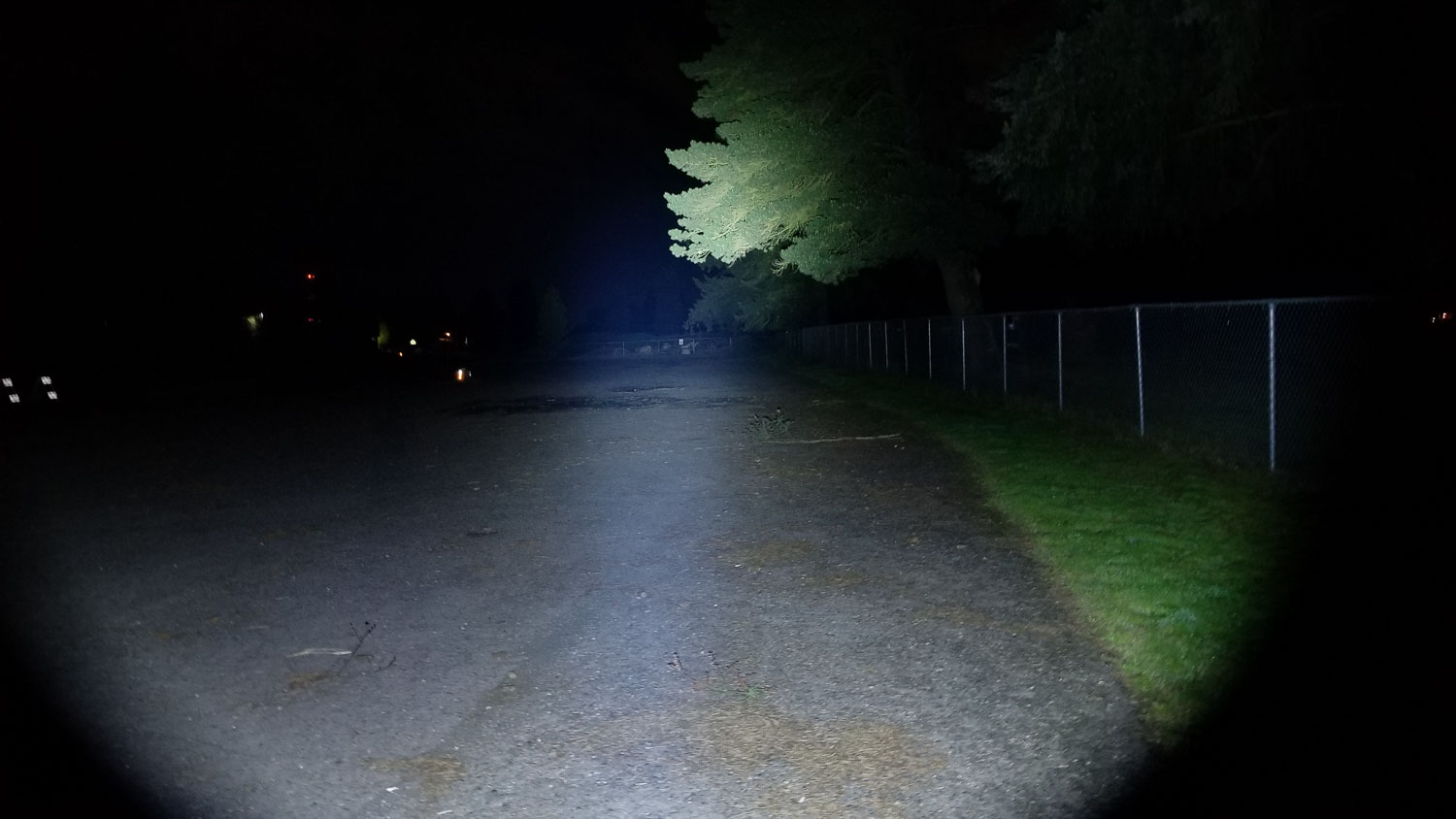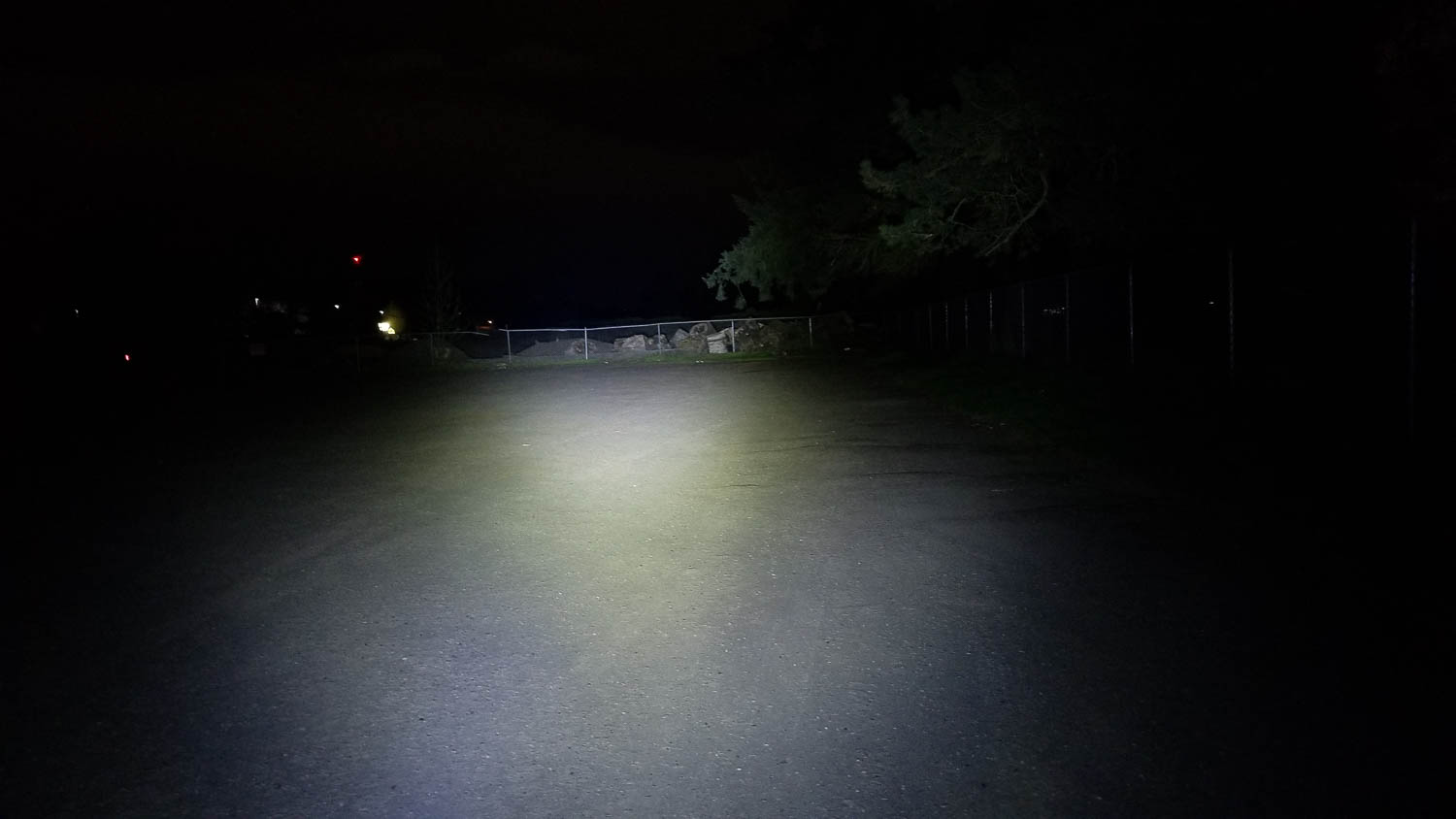1lumen selects and reviews products personally. We may earn affiliate commissions through our links, which help support our testing.
Fenix TK20R V2 review
Fenix TK20R V2 specifications
| Brand/model | Fenix TK20R v2 |
|---|---|
| LED | Luminus SFT-70 |
| Max. Lumens | 3,000 lm |
| Max. Beam intensity / distance | 56,600 cd |
| Battery config. | 1*21700 |
| Onboard charging | USB-C |
| Modes | 6 |
| Blinkies | Strobe |
| Reflector | Smooth |
| Waterproof | IP68 |
| Review date | May 2022 |
Introduction:
Today I’ll be taking a look at another new Fenix product, and another second edition of an existing light. This time it’s a tactical-use flashlight, and if we’ve learned one thing about Fenix here at 1Lumen, it’s that they have carved out a pretty deep niche in this particular corner of the market, producing some excellent and well-made professional-quality lights. EDC, tactical, WML, duty, and general-purpose lights are all available across several product lines.
Fenix also carries the distinction of selling in many retail stores in the US and abroad, so after-sale support for Fenix lights is excellent. I’ve reviewed several Fenix lights from the PD, E, and TK-series, and have been impressed with their performance and overall high quality. For this review, they were kind enough to send out their TK20R V2. This is an updated version of the TK20R light, and is part of the TK-series, larger lights designed for longer throw and higher output. On paper, this new version is a substantial upgrade to the existing model, promising triple the output, more throw, and nearly double the battery capacity. Let’s dig in.
Package quality.
Fenix once again sticks the TK20R v2 in their signature, retail-friendly orange and black color schemed package. That’s a good thing because all the good stuff is front and center with nice graphics, feature blurbs, and specs galore, nice eye candy for window shoppers. Inside, the light is riding in a molded thin plastic carrier, and this time it has the hinged bottom cover, and I really like this design because anyone who’s pulled out a flashlight from a box and had all the accessories spill out all over the ground will appreciate this design. Here’s what’s inside:
- Fenix TK20R v2
- Fenix ARB-L21-5000 v2 21700 (loaded in the light)
- Manual
- Warranty card
- Lanyard
- Holster
- Spare o-rings
- USB type A to C charging cable
Overall, this is expected in a flashlight of this type and price. It’s RTR (ready-to-run) with everything needed (including Fenix’s excellent 5000 mAh protected battery, a $25 value) to open the box and get on with it. The accessories are nice and seem to be great quality. I especially like the super-sturdy lanyard with adjustable cinch.
Flashlight in use
The Fenix TK20R v2 is a dual-role tactical-use and general purpose flashlight, and would be equally happy riding on the end of a long gun, a duty belt, work belt, battle rattle, MOLLE gear, or in a toolbox. First responders, security, law enforcement, S&R, and other professionals would be the primary users, but it would be an excellent general-purpose light as well. The 1-inch diameter battery tube feels excellent in the hand and it would fit just about any hand size perfectly, from meat mitts to Hobbit hands, with or without gloves. The whole thing weighs a hair over 200 grams loaded, so it’s properly lightweight to minimize hand fatigue during prolonged operation. Reducing weight is also important for using on a duty belt, which might also carry a firearm, holster, ammo pouches, magazines, handcuffs, and other gear, so every gram counts! It’s nicely balanced and points naturally in over and underhand grips. It’s less suited for a cigar-type grip though. The texturing on the battery tube is the typical Fenix-centric reeding, and vertical micro-grooves on the charge port cover made twisting the cover open and closed very easy.
The first generation TK20R featured a rear clicky and side e-switch switch arrangement, but the V2 has adopted the TK16 V2’s arrangement, consisting of a momentary e-switch and a forward clicky switch positioned on the tailcap. The smaller, oval-shaped e-switch is for instant Strobe and mode changes. It’s positioned above the larger circular mechanical forward clicky switch, which is for on and off or momentary operation. The mechanical switch has a great feel, with solid, snappy clicks and great feedback. It also sticks out quite a bit, which makes manipulation easy when wearing gloves. The e-switch is nice also and sticks out enough to be tactile with gloves on although the clicks and feedback aren’t as positive. Both switches are weighted very nicely with the right amount of resistance to clicks to avoid accidental activation. I had no trouble manipulating both switches with my thumb in the overhand grip.
The Fenix TK20R V2 is compact enough to fit in a jacket pocket, and thanks to the strong pocket clip and lanyard mounting points (clip, and two in the tailcap), along with the holster, there’s lots of retention options. The pocket clip can be removed, and Fenix offers a ton of accessories for mounting to a weapon (M-LOK rail mount, clamp-type barrel mounts and a remote switch) and accessories for duty use like a traffic cone, diffuser, red filter, quick-release duty holster, and belt clip.
Build Quality, and Warranty
Well it’s a Fenix product so ‘nuff said. Just kidding, but Fenix lights are very high quality items, like a premium hand tool. The TK20R V2 carries this forward, and the price is commensurate, coming in around $130 US. Although a bit steep, it’s not an unreasonable price for a professional-grade tool that will be reliable and last a long time. Olight, Acebeam, Nitecore all have similar lights at similar prices, so the price is competitive.
The light is milled from 6061-T6 aluminum, and the machining is super-tidy, with no machine or tool marks, no blemishes, and every edge has been knocked down and smoothed. In case you’re wondering, smooth edges are just good for your hands, they make it easier when drawing or re-holstering the flashlight since there’s no abrupt edges to catch on things. The engraving and silkscreen text is super sharp as well, and all the parts fit together perfectly, including the retractable charging port cover, which unscrews super-smoothly with no wobbles or play whatsoever. Even the battery fits in the tube perfectly: It’s loose enough to easily extract, but does not rattle around at all. The finish is a semi-gloss type III HA anodizing and it’s very high quality and durable. My other Fenix lights get knocked around sometimes, and they’re holding up great.
The light cannot be disassembled, and the only removable part is the tailcap, which has fully anodized (for mechanical lockout), large, and very precisely machined rectangular threads. They’re very generously lubed and super-duper smooth. The threads for the retractable charge port cover are triangular cut and sturdy enough, and ultra smooth.For springs, there’s two at work here. The driver and tail spring are thick gold-plated units, and that’s important in a tactical or professional-use light since they act like shock absorbers in the event the light is dropped (or smashed against a hard object). It’s also mission-critical for weapon-mounted duty wherein the springs absorb recoil energy that can be transferred to the driver and cause damage or connection breaks from the battery rebounding off the driver contact. Unlike other lights with dual switches, there’s no signal tube, thanks to both switches being mounted on the tailcap. Although there’s nothing wrong with the signal tube design, and lots of other manufacturers use it, it eliminates a potential failure point and makes for a more robust design for greater durability. It’s rated for a proper IP68 water resistance, even with the charge port uncovered, good for up to 1 meter immersion of up to 30 minutes. Very impressive and great attention to detail!
Warranty? One of the best out there with support in the US and abroad: Fenix Lighting US, guarantees all Fenix products purchased from retailers to be made of first-class materials and therefore provides a lifetime warranty against any defects in material and workmanship. Excluded from warranty coverage is any damage to the exterior deemed reasonable wear and tear such as scratches and/or fading of color. In addition, the warranty does not apply to damage caused by abnormal or unreasonable use of any of the components. This includes use of unapproved batteries in Fenix products.
This warranty is in place of all other warranties, including warranty of fitness for a particular purpose and warranty of merchantability and excludes any liability for incidental or consequential damages. If your Fenix product has a manufacturer’s defect covered by our warranty, we will either repair or replace it, at our option, without charge. Most damaged Fenix products not covered by the warranty can still be repaired. If repair costs and handling charges apply, you will be notified prior to any service. All warranty repairs or replacements are at the sole discretion of the Fenix Lighting US Authorized Repair Center and we reserve the right to refuse a request.
LED, Lens, Bezel, Beam, and Reflector
Fenix doesn’t conceal the identity of the LEDs they use, which I think is a nice concesion for consumers who care about such things. Whereas the majority of Fenix’s higher output lights are fielding the Luminus SST70, for the TK20R V2 it’s been booted in favor of its domeless stablemate, the SFT70. This is an entirely new LED, and hasn’t had much exposure in the flashlight continuum. I can’t find a data sheet for this LED, and I haven’t seen it featured in any other mainstream lights besides the Olight Warrior 3 and 3S. I do know it’s a 5050 (5mm x 5mm) footprint, so it fits anywhere the SST70 fits, and it runs on 6 or 12 volts. Like the SST70, it retains the quad die arrangement on a single substrate. The dies are pretty close together, but not as close as something like an XHP35 HI, and the design is similar to the SFT-40-W in that the bond wires are embedded in the substrate. This helps current handling and heat dissipation at higher drive currents.
The LES is about 6.4mm2, so a tad smaller than an XHP35 HI at around 5.3 mm2. The LES isn’t perfectly symmetrical either, but more rectangular in shape, and combined with the dark gaps between the dies, this means careful focusing is required in SMO reflectors. The closest competitor to this LED is going to be the Cree XHP50.3 HI, with similar output. No tint is specified, but it’s pretty cool, and like every other CW Luminus product, it’s a bit green at lower drive currents and the Opple Lightmaster Pro agrees. The High setting comes in at 5816K and 63.6 Ra with a duv of 0.0113. Turbo kicks that up to 6299K and RA 66.0. The duv is 0.0079, so we can see how lower current=more green, higher current=less green. It’s not at all distracting though and fine for the intended purpose.
The bezel is what looks like a finely-machined blackened stainless steel unit that’s nicely crenulated for some hardcore strike action (if called upon). The very purple AR coated toughened mineral glass lens is set back from the edge of the bezel a good 4.5 mm, so it’s well-protected from drops (or banging it against things). The beam is nicely tuned for a tactical-use/general purpose light like this, so there’s some generous spill with a bright good-sized hotspot. There’s one issue though, because this beam has a case of donut hole-itis. It’s not very noticeable, and it takes a white wall to find it out to 5 meters, but it’s mostly invisible anywhere else. Honestly, I doubt anyone but the most finicky beamaholics will care though. For a sub-40 mm head, this thing has plenty of reach and is properly bright; every bit as much as the domed SST70 in the TK16 V2 and PD36R Tac, with better distance.
Dimensions and size comparison
- Length: 15.3 cm / 6.02 inches
- Head diameter: 3.4 cm / 1.3 inches
- Body diameter: 2.54 cm / 1 inch
Weight:
- With battery: 204.8 grams / 7.22 oz
- Without battery:132.5 grams / 4.67 oz
Flashlight competition comparison
I compared the TK20R V2 to some other tactical-use flashlights and general-purpose flashlights. The TK20R V2 is similar in size to the TK16 V2, and close to the Cyansky K3 long-throw tactical light.
Group 1 left to right: Thorfire C8, Fenix TK20R V2, Speras E3, Cyansky K3
Group 2 left to right, a bunch of Fenix flashlights: Fenix ARB-L21-5000U, Fenix E09R, Fenix PD32 v2, Fenix PD35 v3, Fenix TK20R v2, Fenix TK16 v2, Fenix PD36R Tac
Group 3 top to bottom: Fenix TK20R V2, TK16 V2
Group 4 left to right: Fenix TK20R V2, Fireflies E07 2021, Acebeam L17, Klarus XT11GT Pro V2, Wuben C2
Driver & User Interface:
Like other professional-use lights, the TK20R V2 features a boost driver. The output stays consistent until LVP kicks in. This is obviously important for professional use since it’s no bueno for your light to go dim during a steakout or search and rescue mission, right?
The UI is typical of Fenix’s other duty and tactical-use lights, consisting of 5 regular modes and a single Strobe controlled by either the momentary e-switch (Function switch) or the mechanical clicky switch (Tactical switch).
Available modes: Eco, Low, Medium, High Turbo, Strobe.
From OFF:
- Press and hold Functional switch: Strobe
- Single click Tactical switch: Turns on
From ON:
- Press and hold Functional switch: Strobe: Turns off
- Single click Tactical switch: Turns off
- Press and hold Tactical switch: After about 1 second, activates Strobe
- Single click Function switch: Changes modes E-L-M-H-T-E
Mode memory
- Yes, remembers the last used mode when switched off
Shortcuts:
- Pressing and holding the Tactical switch for about 1 second activates Strobe
Low voltage warning:
- The battery indicator LED will indicate the battery state when the light is turned on and stay illuminated for about 3 seconds. Solid green 85% to 100%, blinking green 50% to 85%, solid red 25% to 50%, flashing red 1% to 25%. I also noticed visual LVP, with the light blinking three times about every 5 minutes after the last step down.
Strobe/blinkies
- Yes, Strobe
Lock-out mode:
- None, but the light can be locked out by unscrewing the tailcap 1/8 turn
PWM
- None and not visible by camera
Additional info on the UI: Generally, this is a very sound and effective UI for professional-use and tactical use with instant Strobe available from both the Function switch and Tactical (clicky) switch. Although there’s not a dedicated instant Turbo mode, there is mode memory, (which some might see as a detriment), which enables quasi-instant Turbo since the light remembers the last mode. Turn it off in Turbo, and you have instant Turbo when switching on again. In proper tactical-use form, electronic lockout is eliminated, but mechanical lockout is available. Although the LED indicator will happily tell you the state of the battery when switched on, you need to unscrew the charge port cover to see it, and although Fenix says the charge port is waterproof to IP68, dirt, mud, or grime can get into the charge port and gum it up. An external LED would have been a much better option here. Overall, a decent UI for a light like this, with no visible PWM and it integrates Fenix’s version of thermal regulation called IOP to kick in at 55-60 C with a timed Turbo step down that can be reactivated after a short time.
Batteries & Charging
Like the Fenix TK16 v2 and the other larger TK and PD-series lights, the Fenix TK20R V2 takes a 21700-size battery. These offer a considerable capacity and current-handling advantage over the smaller 18650-size batteries, without adding excessive size or weight to the light. The kit includes Fenix’s excellent ARB-L21-5000 V2 battery. This is a button-top 5000 mAh 21700 with a protection board. It’s about 75 mm long, so a bit long, but the longer 5000U (built-in charging version) will also fit, but flat top unprotected cells were too short. My button top Epoch 50Gs fit, and so did the Cyansky protected 5000 mAh 21700, and the Acebeam protected 21700 with USB charging. Fenix doesn’t recommend using non-Fenix batteries, and you risk voiding the warranty for using “unapproved batteries” which also include CR123 and 18650-size cells. The Fenix battery has built-in LVP, and I’m not sure if it’s also built into the driver as well.
The Fenix TK20R features a USB type C set to 2 amps. I stuck it on my USB tester and got around 2.1 amps max, and this charged the battery in about 3.5 hours. Charging also worked with USB type C to C charging as well, with no change in the charging current. I did notice some quirks with charging though. The battery generally charged to between 4.1 and 4.07 volts, measured when I pulled the battery after the current dropped to 0 amps. Depending on the charging adapter I used (I tried 3), sometimes the battery charged to 4.19 volts, but only after reattaching the charging cable a few times. Other times I noticed the LED indicator blinking red during charging. This didn’t seem to affect overall performance, although I would have preferred to see the cell charged to 4.19 volts consistently to get the most runtime out of it.
Performance test
Lumen measurements (for each mode)
Lumens are measured using my home made 30 cm integrating sphere, and I use a Digi-Sense 20250-00 datalogging luxmeter. The sphere has been calibrated using many lights of known output, including a Makkua calibrated Convoy S2+. All measurements taken at 30 seconds with the fully charged ARB-L21-5000 V2 5000 mAh battery. I didn’t measure the current due to the design of the tailcap and current path.
| Mode | Specs | turn on | 30 sec | 10 minutes |
|---|---|---|---|---|
| Eco | 30 | 29.88 lm | 29.88 lm | – |
| Low | 150 | 141 lm | 141 lm | – |
| Med | 350 | 299 lm | 299 lm | 291 lm |
| High | 1000 | 855 lm | 855 lm | 647 lm |
| Turbo | 3000 | 2540 lm | 2241 lm | 581 lm |
Parasitic drain:
- 2.1 µA
Runtime graph
I tested the runtimes in the 30 cm integrating sphere using the Digi-Sense 20250-00 datalogging luxmeter. I tested Medium, High, and Turbo modes utilizing the fully charged included battery.
Turbo started at a bit over 2500 Lumens, which is pretty good. Fenix specifies a Turbo step down when the driver hits 60 C, and my stepdown happened at about 60 seconds, which is pretty decent, but the stepdown was dramatic: down to a bit over 500 Lumens. You can reactivate Turbo after the step down though. The output is rock solid until another step down at 1 hour 22 minutes, down to 249 Lumens for another 1 hour 12 minutes. The final step down happens at 2 hours 14 minutes when LVP kicks in. I did notice visual LVP at this point; 3 blinks every 5 minutes. Nice! This continued until shut down at 2 hours 43 minutes. Fenix says Turbo should run for 2 hours 50 minutes, so pretty bang-on! Heat wasn’t an issue here, but it got hot quick: From 23.5 C ambient to 52.8 C by 10 seconds, down to 49 C by 30 seconds. Thermal regulation was excellent though, and the light was hand-friendly the entire runtime. The battery measured at 2.8 volts after the test.
High started at 854 Lumens, down a bit from advertised, but it was consistent, holding better than 800 Lumens for almost 10 minutes. From there, it was gradual step downs over the next 2 hours until 2 hours 11 minutes when the output dropped to under 300 Lumens, and from there another step down to 100 Lumens at 3 hours 2 minutes, and finally LVP kicks in 30 minutes later (3 hours and 32 minutes), pulling the output down to 24 Lumens. It ran this way for another 3 hours before shutting down at 6 hours 26 minutes. Fenix says this mode should run 3 hours 10 minutes, and the last significant step down is at 3 hours 2 minutes, so they could be basing it off that. The hottest the light got was 50 C, measured at 1 hour.
Medium was uneventful and not surprisingly ran a long time. The output was better than 250 Lumens for almost 6 hours, and the last step down happened at 6 hours 13 minutes, but it kept running for another 3.5 hours. Fenix specified 7 hours for this runtime.
This what I’ve come to expect from higher-end Fenix lights using the SST70 LED with a boost driver: Excellent regulation and laminar runtime graphs. Although this isn’t an apples-to-apples comparison, judging from the graphs, it seems as though there haven’t been many meaningful performance gains with this new LED versus the older SST70 in real-world use. Professional users demand consistent light output, and the TK20R V2 delivers here. The thermal regulation is excellent as well, with zero drama, sawtooths and consistent output. The light was also hand-holdable throughout the Turbo test as well, and if you need Turbo, reactivating it is possible once it cools off. I also like the fact that there’s visual LVP in addition to the LED indicator: After the last step down, the light blinks 3 times every 5 minutes until shut down.
Throw numbers:
Throw was measured using the Uni-T 383S luxmeter at 5 meters indoors. Readings taken at 30 seconds using the included Fenix ARB-L21-5000 V2 battery.
| Mode | Specs | Candela measured | Meters | Yards |
|---|---|---|---|---|
| Eco | 490 cd | 700 cd | 53 | 58 |
| Low | 2500 cd | 3125 cd | 112 | 122 |
| Medium | 5860 cd | 7225 cd | 170 | 186 |
| High | 17,620 cd | 23,125 cd | 304 | 333 |
| Turbo | 56,600 cd | 23,875 cd (62,225 cd at start) | 309 (499 at start) | 338 (546at start) |
This is very respectable throw for a sub-2 inch reflector, and the SFT70 is throwing quite a bit farther than the domed SST70 TK16 V2. The startup rating is beating the Fenix-spec 475 meters as well. The output drops dramatically at 30 seconds for the Turbo step down so the throw goes way down.
Beamshots
I tested the TK20R V2 against some similar flashlights, including its 21700-sized counterparts:
- Fenix PD36R Tac
- Fenix TK16 V2
- Fenix PD35 V3
- Sofirn SC31T
- Klarus XT11GT V2
- Wuben C2
- Thrunite BSS V4
- Astrolux EA01
The fence is about 40 m away. You can see the differences in beam profiles and throw distance pretty well.
Disclaimer: This flashlight was sent to me for review at no cost by Fenix Lighting US. I have not been paid to review, nor have I been holding back on problems or defects.
Final Verdict
Pros
- Fantastic quality, fit and finish
- Complete kit with battery
- Great performance with decent throw
- Nicely regulated driver
- Effective dual-switch UI
- Onboard USB C charging
Cons
- Donut hole in the beam
- Inconsistent charging termination
- Only charged the battery to 4 volts
Explanation on star ratings:
1: Avoid: my phone flashlight would be a better choice – 2: Poor: significant defect or issues; almost unusable – 3: Average: some defects or issues; but still usable 4: Good: recommended (minor issues) – 5: Great: highly recommended
5 stars: ★★★★★
Once again Fenix has proven two things: One, they know how to make a great flashlight, and two, they’re an innovative brand that endeavors to keep making great lights. The proof is in the pudding, because so far, this is the 5th Fenix light I’ve reviewed that’s a 2nd (or 3rd in the PD35 V3’s case) generation of an existing product, and they’ve all featured meaningful and effective upgrades.
The Fenix TK20R V2 represents an important fixture within the TK series in that it’s one of the few in the tactical-use lineup that features onboard charging, which appeals to a lot of buyers and users. Onboard charging aside, there’s a lot to like about this light. It brings to bear everything I expect from a Fenix light: Impeccable build quality, fit, and finish, a great warranty with global support, and professional-level fully regulated output. You get nice handling manners and great output as well, and the domeless SFT70 has pretty decent reach for a sub-40 mm reflector. It’s also fully-featured, with every accessory needed to turn it on and get to work. The attention to detail is also nice, like retaining the IP68 rating even with the charge port cover retracted and visual LVP notification. Nice!
There’s not much I can really fault this light for, and the cons I listed, all things considered, are minor annoyances and don’t really detract from the light’s overall performance. Yah, donut holes in beams are a drag, but in this case, it’s mostly invisible, taking someone (me) used to staring at flashlight beams while shining it on a white wall to notice, and for a light like this, most users won’t care anyway. Same with the battery being slightly undercharged and the inconsistent charging. It will keep the battery healthy and ensure a long service lifespan, and if you leave it alone and let it charge until the light turns green, you’re golden.
This is another solid offering from Fenix, and I highly recommend the TK20R V2 to anyone looking for an excellent duty and tactical-use light. 5 stars for the TK20R V2.
Buy Fenix TK20R v2 with our discount coupon
Get 10% off every purchase at Fenix Lighting US, by using our exclusive 1lumen discount code: 1lumen10
1lumen selects and reviews products personally. We may earn affiliate commissions through our links, which help support our testing.
